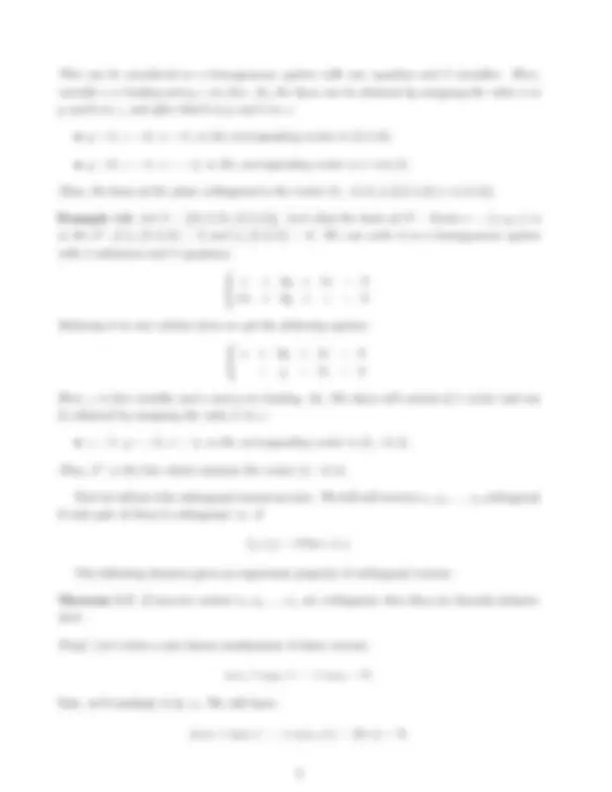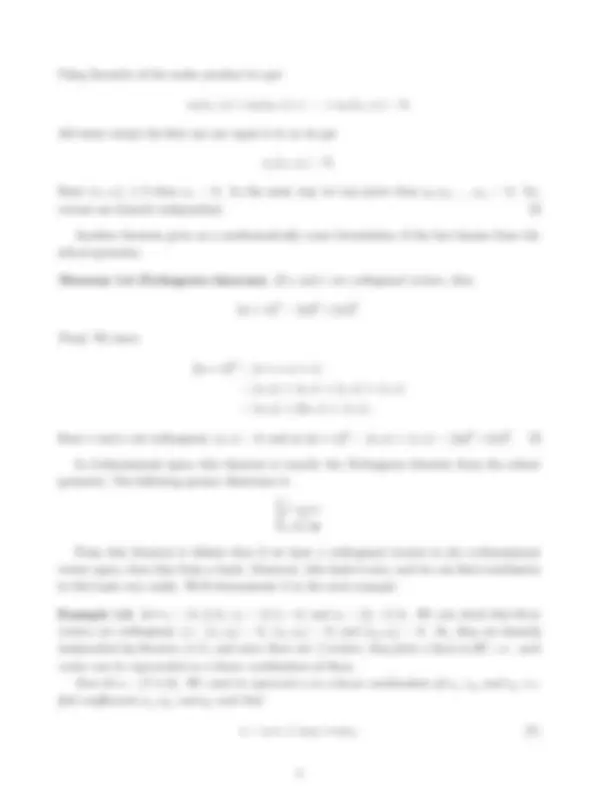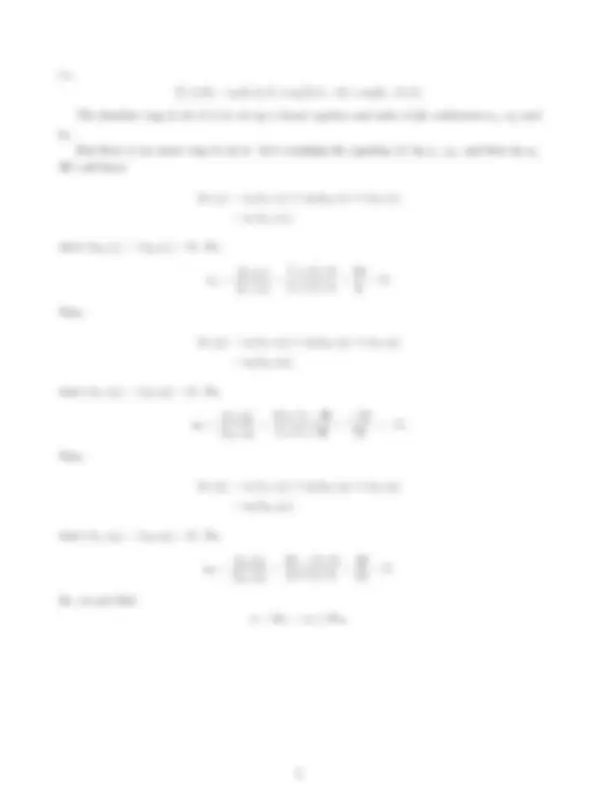





Study with the several resources on Docsity

Earn points by helping other students or get them with a premium plan


Prepare for your exams
Study with the several resources on Docsity

Earn points to download
Earn points by helping other students or get them with a premium plan
Community
Ask the community for help and clear up your study doubts
Discover the best universities in your country according to Docsity users
Free resources
Download our free guides on studying techniques, anxiety management strategies, and thesis advice from Docsity tutors
The concept of orthogonality in euclidean spaces, including the definition of the angle between two vectors, normalization, orthogonal complement, and orthogonal vectors. It also includes examples of finding the basis of the orthogonal complement for given vectors.
Typology: Study notes
1 / 5

This page cannot be seen from the preview
Don't miss anything!




Let V be a Euclidean space, and let v and u be 2 vectors in this space. Then we can define the angle between these 2 vectors.
Definition 1.1. The angle θ between two vectors v and u from the vector space V can be defined by the following formula:
cos θ = 〈u, v〉 ‖u‖‖v‖ Actually, we should check that this definition is correct — we have an expression for cosine, and it should belong to the interval [− 1 , 1]! It is easy to check. From Cauchy-Bunyakovsky- Schwartz inequality we have |〈u, v〉| ≤ ‖u‖‖v‖,
and so we will have − 1 ≤ (^) ‖〈uu, v‖‖v〉‖ ≤ 1
Let’s note that this is a general definition which works in many different spaces, and not only in R^2 and R^3. For example, by this formula we can define the angle between two functions from C[a, b] or between two polynomials.
Example 1.2. Let u = (1, 2 , 3) and let v = (− 1 , 2 , −2). Then 〈u, v〉 = −1 + 4 − 6 = − 4 , ‖u‖ =
14 , and ‖v‖ =
1 + 4 + 4 = 3. So, the angle θ between these two vectors can be defined by the following formula:
cos θ = 〈u, v〉 ‖u‖‖v‖
Another important concept is a normalization of the vector.
Definition 1.3. If v is a vector from the vector space V then the vector
v ‖v‖
is called a normalization of v.
The main property of normalization is that it’s norm is equal to 1. So, we take a vector which is proportional to v with the “length” 1. Now we’ll give the very important definition — main definition of this lecture.
Definition 1.4. Two vectors u and v are called orthogonal if
〈u, v〉 = 0.
Let we have a vector v from the Euclidean space V. Let’s consider all vectors u which are orthogonal to v, i.e. the set of vectors u such that 〈v, u〉 = 0:
v⊥^ = {u ∈ V |〈u, v〉 = 0} (read “v-perp”)
This set is called the orthogonal complement to the vector v. Now let S be a set of vectors. Then we can define S⊥^ as the following set:
S⊥^ = {u ∈ V |〈u, v〉 = 0 for all v ∈ S}
This set S⊥^ is called the orthogonal complement to the set S. Let’s note that S⊥^ is a vector space. First, 0 is orthogonal to any other vector, since 〈 0 , v〉 = 0 for all v. So, 0 ∈ S⊥. Now, let u 1 , u 2 ∈ S⊥, such that 〈u 1 , v〉 = 0 for all v and 〈u 2 , v〉 = 0 for all v. So it follows that 〈u 1 + u 2 , v〉 = 〈u 1 , v〉 + 〈u 2 , v〉 = 0, and thus u 1 + u 2 belongs to S⊥. Moreover, it is obvious to check that if u belongs to S⊥^ then ku belongs to it. Thus, we proved that S⊥^ is a vector space. Geometrically speaking, let’s consider the case of 3-dimensional space. Let v be a vector from the 3-dimensional space, then v⊥^ is the plane which is perpendicular to this vector. Now let’s consider more difficult case, when S consists of 2 vectors v and u. In this case the line L will be orthogonal to both vectors. It is illustrated on the picture below.
°
°
° °
°
° °
°
°
6
u v L
Our goal is to describe u⊥^ or S⊥^ somehow, for example give a basis of it. Actually, for the simple spaces, like Rn^ the basis of the orthogonal complement can be found as a basis in the solution space of the corresponding homogeneous system. We’ll show it on the example.
Example 1.5. Let v = (1, − 3 , 4). Let’s find the basis of the orthogonal complement to u, i.e. the basis of u⊥. Vector u = (x, y, z) is orthogonal to v if 〈v, u〉 = x − 3 y + 4z = 0. So, we have an equation: x − 3 y + 4z = 0.
Using linearity of the scalar product we get:
a 1 〈v 1 , v 1 〉 + a 2 〈v 2 , v 1 〉 + · · · + an〈vn, v 1 〉 = 0.
All terms except the first one are equal to 0, so we get
a 1 〈v 1 , v 1 〉 = 0.
Since 〈v 1 , v 1 〉 6 = 0 then a 1 = 0. In the same way we can prove that a 2 , a 3 ,... , an = 0. So, vectors are linearly independent.
Another theorem gives us a mathematically exact formulation of the fact known from the school geometry.
Theorem 1.8 (Pythagoras theorem). If u and v are orthogonal vectors, then
‖u + v‖^2 = ‖u‖^2 + ‖v‖^2.
Proof. We have:
‖u + v‖^2 = 〈u + v, u + v〉 = 〈u, u〉 + 〈u, v〉 + 〈v, u〉 + 〈v, v〉 = 〈u, u〉 + 2〈u, v〉 + 〈v, v〉.
Since v and u are orthogonal, 〈u, v〉 = 0, and so ‖u + v‖^2 = 〈u, u〉 + 〈v, v〉 = ‖u‖^2 + ‖v‖^2.
In 2-dimensional space this theorem is exactly the Pythagoras theorem from the school geometry. The following picture illustrates it:
? -
ZZ u (^) vZu+vZ~
From this theorem it follows that if we have n orthogonal vectors in the n-dimensional vector space, then they form a basis. Moreover, this basis is nice, and we can find coordinates in this basis very easily. We’ll demonstrate it in the next example.
Example 1.9. Let v 1 = (1, 2 , 1), v 2 = (2, 1 , −4) and v 3 = (3, − 2 , 1). We can check that these vectors are orthogonal, i.e. 〈v 1 , v 2 〉 = 0, 〈v 1 , v 3 〉 = 0, and 〈v 2 , v 3 〉 = 0. So, they are linearly independent by theorem (1.7), and since there are 3 vectors, they form a basis in R^3 , i.e. each vector can be represented as a linear combination of them. Now let u = (7, 1 , 9). We want to represent u as a linear combination of v 1 , v 2 , and v 3 , i.e. find coefficients a 1 , a 2 , and a 3 such that
u = a 1 v 1 + a 2 v 2 + a 3 v 3 , (1)
i.e. (7, 1 , 9) = a 1 (1, 2 , 1) + a 2 (2, 1 , −4) + a 3 (3, − 2 , 1). The familiar way to do it is to set up a linear system and solve it for unknowns a 1 , a 2 and a 3. But there is an easier way to do it. Let’s multiply the equality (1) by v 1 , v 2 , and then by v 3. We will have:
〈u, v 1 〉 = a 1 〈v 1 , v 1 〉 + a 2 〈v 2 , v 1 〉 + 〈v 3 , v 1 〉 = a 1 〈v 1 , v 1 〉,
since 〈v 2 , v 1 〉 = 〈v 3 , v 1 〉 = 0. So,
a 1 = 〈u, v^1 〉 〈v 1 , v 1 〉
Now,
〈u, v 2 〉 = a 1 〈v 1 , v 2 〉 + a 2 〈v 2 , v 2 〉 + 〈v 3 , v 2 〉 = a 2 〈v 2 , v 2 〉,
since 〈v 1 , v 2 〉 = 〈v 3 , v 2 〉 = 0. So,
a 2 =
〈u, v 2 〉 〈v 2 , v 2 〉 =
Now,
〈u, v 3 〉 = a 1 〈v 1 , v 3 〉 + a 2 〈v 2 , v 3 〉 + 〈v 3 , v 3 〉 = a 3 〈v 3 , v 3 〉,
since 〈v 1 , v 3 〉 = 〈v 2 , v 3 〉 = 0. So,
a 3 = (^) 〈〈vu, v^3 〉 3 , v 3 〉^
So, we got that u = 3v 1 − v 2 + 2v 3.